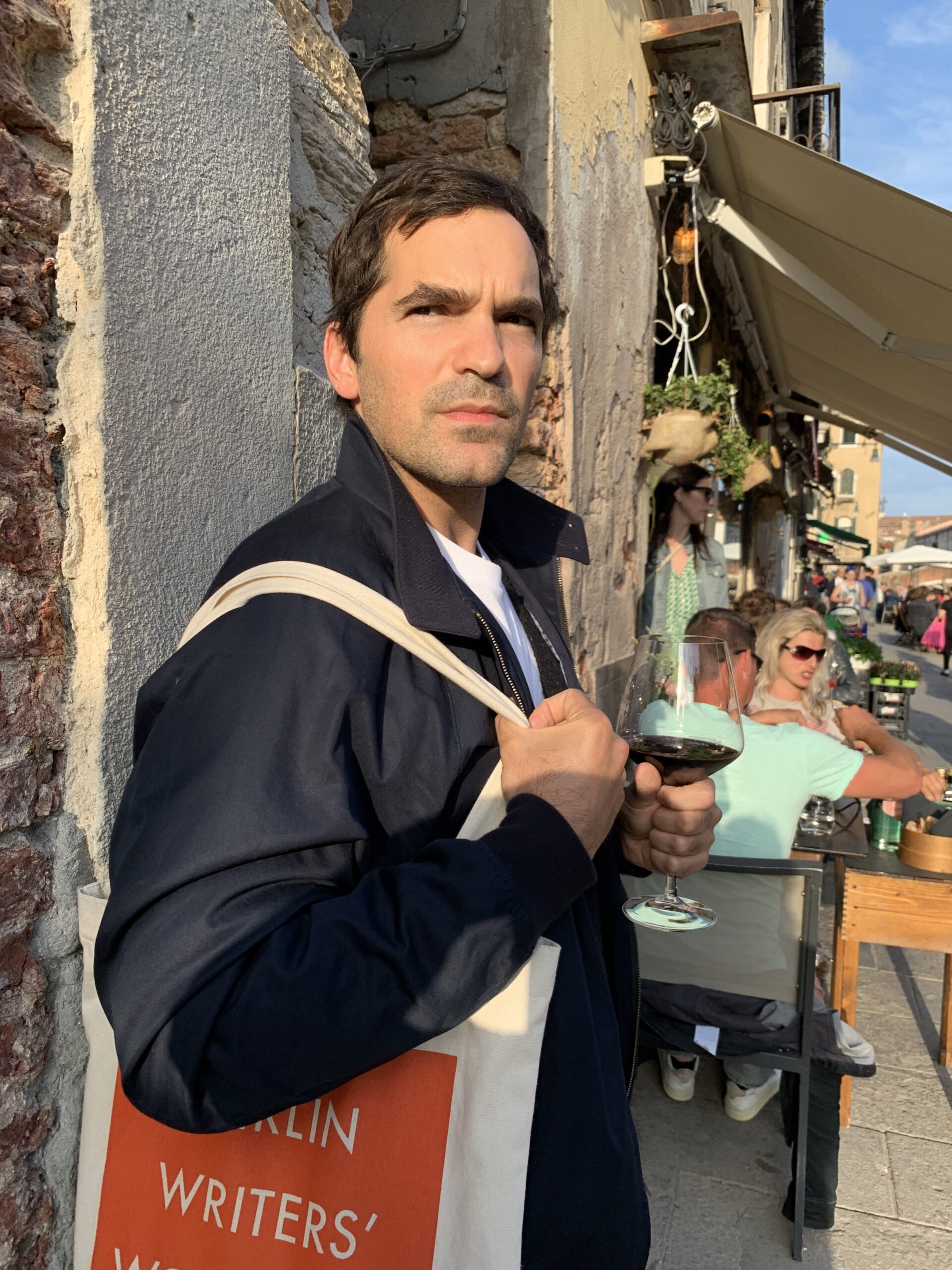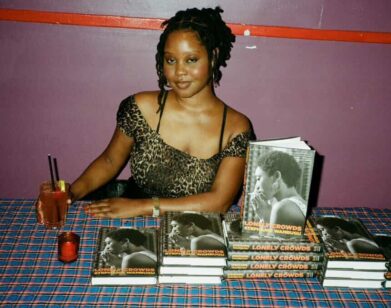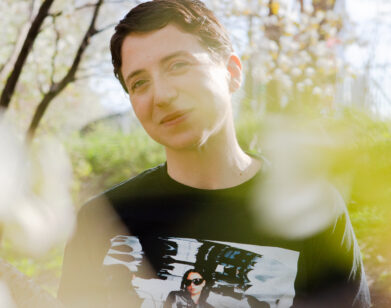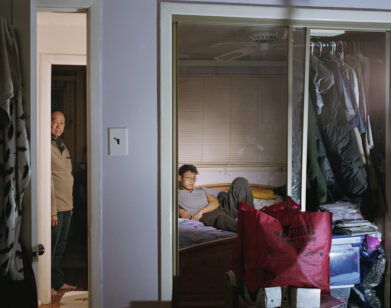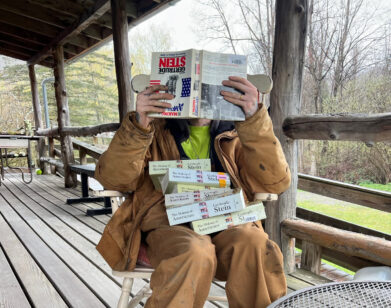LIT
Bennett Sims on Style, Sebald, and His New Short Story Collection
Last month, I attended a boozy party at the Brooklyn apartment of the novelist Mark de Silva. A group in the backyard fell into a round of the classic parlor game: who is the most talented writer of our generation? The host—most recently, the author of the 1,000-page epic The Logos, and thus no slouch in his own right—and I both gave the same answer: Bennett Sims. With his debut novel A Questionable Shape, and his first short story collection, White Dialogues, Bennett established a reputation as a master of psychological horror. He is, in my view, one of the most successful importers to contemporary American fiction of the narrative techniques of European late modernism—the sensibility of David Lynch crossed with style of W.G. Sebald for the age of digital media.
Bennett divides his time between Iowa City, where he teaches in the Nonfiction Writing Program, and Berlin, where he and I met in 2017. As I’ve learned from our many subsequent conversations, he is not only a first-rate practitioner, he also has a fine-grained understanding of how fiction works. (He is one of the few people whose arguments have persuaded me to reconsider some of my most-cherished critical opinions which, with apologies for being coy, I will not reveal here). Recently, over Zoom, I was able to get him to tell me more about some of the technical challenges and considerations involved in generating his new collection Other Minds and Other Stories, which was published last week by Two Dollar Radio.
———
RYAN RUBY: I forget, Bennett, are you a fan of the Oulipian writer Jacques Roubaud?
BENNETT SIMS: I have read The Great Fire of London and enjoyed it, but I have not read much else.
RUBY: The reason I ask is because in the follow-up to that book, Jacques Roubaud talks about what he calls “the Gertrude Stein axiom.” According to the Gertrude Stein axiom, a book is the biography of its title. I wanted to begin by considering the title of your new collection, Other Minds and Other Stories. I thought I’d ask you about the question of the problem of other minds in epistemology, which seems to be an ongoing concern of yours back to your debut, A Questionable Shape.
SIMS: Thank you for that question, and I love that axiom. My first novel, A Questionable Shape, is a zombie novel without zombies. I was really motivated by a fascination and curiosity with both Hollywood zombies and the problem of subjectivity and mind-body philosophy. I wanted to write a novel where Hollywood zombies were approached like philosopher zombies in the sense that my characters are mostly preoccupied with questions about their consciousness. My narrator spends a lot of that novel trying to project himself inside the head of the undead and wondering what it is like to be undead. In the new collection, most of the stories are about characters confronted with another mind, whether it’s another human mind, like a jealous partner who’s wondering if his partner is unfaithful to him. Whether it is an animal mind, like a story about a man beheading some chickens in his backyard. Whether it is non-human minds, from ghosts to snowflakes, or whether it is ekphrastic minds, wondering what an artist might’ve been thinking when making an artwork or wondering what another reader or viewer of that artwork might’ve been thinking when they experienced it. That is the central concern or curiosity of the title story in this collection.
RUBY: Let’s talk about the title story. What was so interesting to me about this particular story is that when philosophers were considering the problem of other minds, they were considering behaviors of another conscious subject. But in the story, the protagonist, who is known as “the reader,” is encountering this problem fundamentally mediated by technology. Could you talk about the way that problem becomes refreshed by its mediation in this technological device of reading?
SIMS: So the narrator is called “the reader,” and there’s a line in that story, if you had asked the reader why he read his entire life, he would’ve answered that he was curious about other minds, which is a line that also appears in another story in the collection. For both of those readers, what they’re going to literature for is to see the world estranged through another writer’s mind. But what the readers get confronted with are not the minds of the writers, but the minds of other readers. In Other Minds, the person reading an e-reader notices this feature of e-readers, which is that you can see how many people have highlighted a single line, and there’ll often be a little pop-up notification as you’re reading like, 670 people have highlighted or underlined this. And he feels this kind of epistemological vertigo that’s familiar to anyone who’s had any aesthetic judgment, like, “I wouldn’t have underlined this line.” And, “This line that I find unremarkable has been remarked upon and highlighted by 600 people.” So instead of having a typical reading experience of inter-subjective connection between himself and the writer, he finds his experience routed through 600 other minds, which are a source of anxiety and increasingly paranoia, for him.
RUBY: One of the through lines of the collection, and what makes it such a remarkable reflection on contemporary life, is the way the characters interact with fundamentally new forms of digital and technological media. When you were working on these aspects of the collection, what were the guiding principles in describing these media forms and technologies?
SIMS: I think it differed from story to story. I was interested in thinking of technology as a new kind of space that might be haunted by the unconscious of the characters. In Unknown, which is a story about possessive jealousy and paranoia, the smartphone was this ready-to-hand prop for externalizing all of the jealous paranoia, because the smartphone is, first and foremost, a tool of surveillance. For something like The Postcard, which is a noir-ish detective story about someone both traveling to a strange place and also traveling into the past, the robotic voice commands of a GPS system became this increasingly uncanny third character guiding the protagonist. The GPS voice becomes a haunted extension of his own sense of displacement in this unfamiliar landscape. Portonaccio Sarcophagus, the street view story, was organized around effacement. The titular sarcophagus in question has these unfinished figures on it where their head should be and the narrator becomes really interested in those and starts connecting them with other images: from a family photograph that seems to feature this ghostly apparition without a face in the background, to the horror movie The Ring. I am not the first person to connect the facial distortions in The Ring to the facial recognition blurring in Google Maps.
RUBY: One of the difficulties of capturing contemporary technology in fiction is the timescales on which fiction and this technology is supposed to operate. Part of the pleasure of literature is its longevity, whereas the fundamental features of these series of technological successions are very accelerated questions of obsolescence. You write about the particular technologies so that they feel not merely like the detritus of our time, but also a fundamental prosthesis of the sort of beings that we are slowly becoming.
SIMS: I think the one technology that I was concerned about the obsolescence of was Twitter. Over the course of writing and publishing that story, it was acquired by Elon Musk, and it’s now known as X and appears to be rapidly deteriorating to the point that who knows how much longer people will be using it. In drafts of that story, I was tempted to use some generic name, just calling it “social media” or “the website.” Patricia Lockwood does that really well by just calling it the “portal.” I decided to just call it Twitter and let it be a mark of our era, even if it quickly vanishes..
RUBY: A number of the stories in your new collection are set in Italy. I counted five. So I want to talk about that particular suite of stories, first by asking about the influence of this particular place on the writing. You split your time between Iowa City and Berlin, and each of these different spaces has, as we would say in German, a different sort of stimmung, so I was wondering what the influence of your time there in Italy was on the production of these stories and how that arranged your concerns. I have theories, but I want to hear what you have to say.
SIMS: I’m more interested in hearing your theories, but I’m happy to answer the question if you promise to tell me your theories afterwards.
RUBY: I promise to tell you my theories.
SIMS: So the simplest answer is that some of those stories were occasional. So the two ekphrastic bookend pieces you mentioned were written as wall text for the images of this photographer, Sze Tsung Nicolás Leong, who was a fellow at the American Academy the year that I was there. He and his partner, Judy Chung, had organized this really interdisciplinary collaborative exhibition of his photographs. The scholars and the classicists and the artists and the dancers and so on got to pick an image of his from Rome, and write a short paragraph to accompany it as wall text. So those two fictions began as ekphrastic wall text in an exhibition and were recontextualized by the frame of the collection as short stories or prose poems. And then Nicolás really graciously allowed me to reproduce his images in the books so that they could remain in dialogue. I was working on the other stories when I was in Rome. I would go to the Palazzo Massimo Museum and I would sit before the Portonaccio Sarcophagus and find myself writing about it. I did not shy away from indulging in the autofictional suggestion that there is some overlap between my narratorial alter ego and myself. A reader is free to imagine that I actually went on the walking tours or visited the landscape installations in Sicily that the protagonist does. One of the things that I really am interested in [Sebald’s] combination of images and text is the way that the images only seem to authenticate the autobiographical nature of the text. And, in fact, it’s just a photograph from a flea market that Sebald has xeroxed a dozen times to look grainy and faded. Or he’ll include a forged photograph of a book burning, a Nazi book burning, where there’s just a plume of smoke that’s been collaged into a courtyard. So this forgery had to be reproduced, which is a fictional image of a factual tragedy or trauma, which I think is how his images work throughout. But there are also question marks on every image because they might be forgeries. I’m happy for the reader to inhabit that image with some ambiguity and to wonder whether that is an image that has been photoshopped, whether that is really an image of my mother or one that I found in a flea market, and to let the uncertainty of those questions reverberate outward through the rest of the story and cast a kind of rippling ambiguity over other details. So that the reader is wondering whether, in fact, I ever visited the Palazzo Massimo in my time in Rome, or whether the other details in the story about my family, or the narrator’s family, are similarly fabricated or embellished toward Sebaldian effect.
RUBY: Yeah, I have no doubt that the reason that this story was my favorite in the collection has to do with its Sebaldian lineage, which you so masterfully summarize here. The collection has great moments of uncanniness and moments of dread, anxiety and even terror that are wrenched out of the banalities of everyday life by meticulous attention to their unfolding and the consciousness of these narrators. I wanted to drill into this particular story because, first of all, it’s an ekphrastic work. Fundamentally, there’s an ancient, in this case, Roman sarcophagus as the fundamental art object that is the kernel of the story. In fact, that’s what I saw all the Italian stories having in common; they were crystallized around some or another particular art object and the reception of that particular art object by the narrator. So I wanted to drill into the minutia of how you were able to achieve these effects and even, in some ways, move beyond Sebald in that you’ve achieved a kind of form that balances the fictional and the critical-essayistic in a way that is extremely pleasant and revelatory.
SIMS: First, thank you for that. It is deeply gratifying to be read so closely and intelligently. Yeah, there are ekphrastic fictions that I was thinking of with that work from Sebald, from Javier Marías, who often has characters respond to artworks or even just historical primary documents that are incorporated in the text. I was also thinking a little about an author I know you like a lot, Peter Weiss. The Aesthetics of Resistance opens with a similar critical-fictional description of art objects at the Pergamon in Berlin.
RUBY: That was when you were writing the opening section?
SIMS: You had recommended that book to me. I had read it by the time I was working on that story, or by the time I was revising it.
RUBY: That pleases me to no end. Go on. I cut you off.
SIMS: I’m interested in the energy that happens in the story when two other people enter that room. It begins with the narrator alone with his thoughts, in this dark room with the sarcophagus. Then, what I was describing in Bernhard is this reversal of his internal monologue, it’s pushed into a new direction by overhearing this conversation that other viewers of this art object have. That pivot is what makes him think about the fungibility and the facelessness of the dead. If he had been thinking of this as a specific tomb carved for a specific tenant, and one of the other viewers speculates that it might’ve been made on spec, as it were, and that the faces were left blank because the artist didn’t know who would be buried in it, anyone could be buried in that. And then the narrator realizes any face could be on those bodies, even my own face or my mother’s face.
RUBY: Your mentioning the word “undead” brings me back to this particular feature, this question of effacement that is so structuring this particular story is a feature of your previous work. For example, in A Questionable Shape, something very similar happens in that the narrator is looking in the rearview mirror of his car while he waits for his friend, who is casing the house of his father, who we are led to believe is among the undead. And the narrator touches the rearview mirror and gets finger oil on it, causing the rearview mirror to smudge. The narrator does two things. One, he anticipates his friend standing in the space of the finger oil smudge and compares that to the painting by Hans Holbein the Younger, The Ambassadors, with its anamorphic smudge across the foreground of the painting. Which, if looked to the side, becomes a death’s head. There’s another moment, which is when the narrator and his friend are contemplating what undead consciousness is like, one of the hypotheses put forward is that undead consciousness is like the quadrant screen of the first person shooter GoldenEye from the nineties.
SIMS: Or our present Zoom call, to update the analogy.
RUBY: Or our present Zoom call, exactly. And that this would be magnified for all undead consciousness, such that each of these particular cells could be viewed simultaneously by each undead person, and that when that person sort of blanks out, one of these cells would go dark. This recalls the same image of the sarcophagus, the fungibility of the face that could be placed in the blank space of the face on the sarcophagus. Here’s the smudgeness that comes through with the horror film The Ring, as well as the photograph, as well as the sarcophagus, as well as the undead consciousness of the zombie present, a motif in your work such that whether or not we are to associate you, Bennett Sims, with the narrative, this particular story returns to the particular concern about the fungibility of consciousness in the face of death. Now that I have you in front of me in one of these small cells that will, after our conversation, go dark, hopefully we will both be retained on either end. This seems to suggest that there is a latent meaning for you, the author, in this particular motif or trope or idea.
SIMS: Yeah, that’s beautiful. I had not made the connection with the rearview smudge or Hans Holbein. But that is, in retrospect, a very obvious and satisfying throughline from the novel to this work. I don’t know if there’s a question at the end of that that you would like me to respond to.
RUBY: [Laughs]. Yeah. The question is, does the return of the motif provide a signature for the author? This could be both in Sebald or in your own adaptation of Sebald’s technique for this particular story, that allows us, the reader, to attribute a greater degree of non-fictionality to the story.
SIMS: That’s a great way of putting it. I like the use of the word signature because that’s certainly how I think about style. Bernhard and Sebald both predate autofiction as a marketing term, at least in anglophone literature, but they’re hugely influential on a contemporary strain of what we think of as autofictional writers, like Ben Lerner or Rachel Cusk or whoever. I think of them as proto-autofictional writers themselves. And Bernhard is someone who certainly courts that collapse of writer with narrator to the extent that he was sued for libel and defamation because he so thinly fictionalized the real life Viennese cultural figures who he was satirizing and ruthlessly ranting about in [Woodcutters]. He was taken to court due to the identification of his biographical self with his narratorial self. That’s obviously true of Sebald, who courts that identification in different ways by lining up his narrators’ biographies with his own. Lydia Davis does this. Ben Lerner does this, not just stylistically, by having his narrators interested in the kind of poetry that he writes, but also biographically by having them be from Topeka and graduates of Brown and so on. I would be happy to have motifs as signatures throughout my work as much as certain stylistic preoccupations.
RUBY: To conclude, I wanted to talk about the two very short stories that bookend the collection. What seemed to be very interesting about those is, first of all, the fact that they were chosen. You open up with a one-page prose poem called La Mummia di Grottarossa and you conclude it with a one-page story called Medusa, which is about a floor mosaic at a museum. The sort of Janus figures that open and close the collection are interesting. These are both figures, one of decay and death but also preservation, in that mummified state. Then at the very end, you write, “Yesterday survives as a pebble in tomorrow’s boot.” So I was wondering just what these two allegorical figures are talking about or saying in relation to the question of the preservative function of language and literature itself.
SIMS: I think my answer is just going to be a less eloquent reiteration of the question. I really like the idea of them being Janus figures, like two sides of the same head looking in different directions on either side of the book. That is how I thought of them, as a frame for all of the stories in between. In La Mummia di Grottarossa, the narrator notes that in the Palazzo Massimo, which is a museum of antiquities, there is one exhibit in the basement that is not like the others. And he notes this tension between this body, that used to be alive and used to be mortal and used to be inside time, [and the marble statues above]. That narrator is really preoccupied with this question of what it would mean to be immortal in art or preserved in art, whether you have a statue made of you or whether you are mummified and then exhibited in a museum or a pyramid, as the case may be. [Whereas in Medusa, the narrator sees a gorgoneion mosaic and] starts thinking about this tradition that the poet Aaron Kunin, in this really brilliant essay called Shakespeare’s Preservation Fantasy, thinks of as the immortality project of poetry. So in that essay, Kunin looks at poems by Shakespeare and Milton and others who fantasize about using the space of the poem to turn themselves or their readers or their beloveds to stone as a way of removing them from time and preserving their beauty or their intelligence or their memory in a space safe from decomposition. One of the aspects of the immortality project that Kunin and the narrator are interested in is the way that language gets pitted against statuary as a more durable medium, that language, unlike stone, does not erode or crumble or fall down So there is this tension in the first story between the mummified body and the marble statue bodies above it, and then there’s this tension across the collection between the petrified or poetified bodies in Medusa and the other kinds of artistic preservations in La Mummia di Grottarossa.
RUBY: I guess I’ll just ask you, point blank. Do you believe in the immortality project of literature?
SIMS: I do. When “the reader” says in both those stories that, if you had asked the reader why he read, he would’ve said he was curious about other minds…that is my answer to that question. One of the things I find moving and mysterious about the medium is that I can pick up a book written by someone who has been dead for centuries, encounter the eccentricity of their consciousness in language, and find the world defamiliarized or estranged through their perceptions of it. I think, to that extent, they are immortal, that their language is preserved from mind to mind through the act of reading. And that’s one of the motifs in another story in the collection, Minds of Winter, when a narrator is making the connection between ice and frost and the term frosting and thinks about the baker who first coined the word frosting, who first put the sugar glaze [on a pastry] and compared it to ice or frost. And he thinks that that metaphor has just successfully jumped three centuries from the mind of this dead baker into his own mind. That is my experience of reading, at least.

